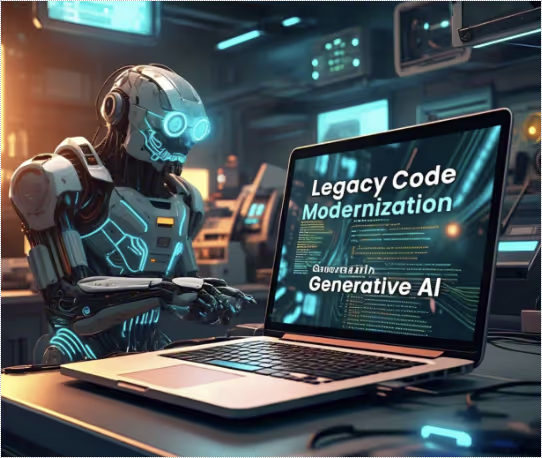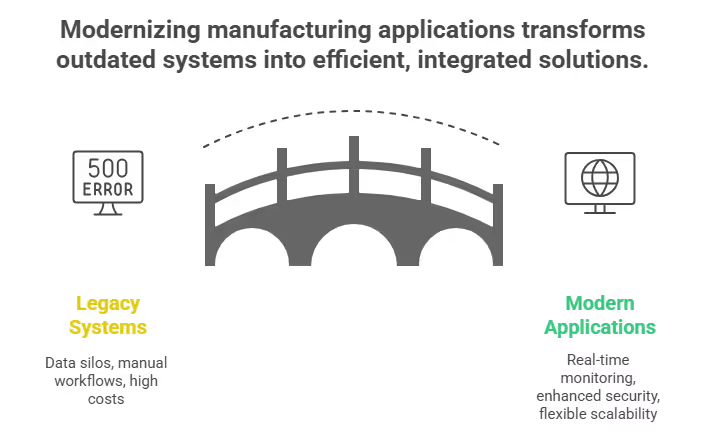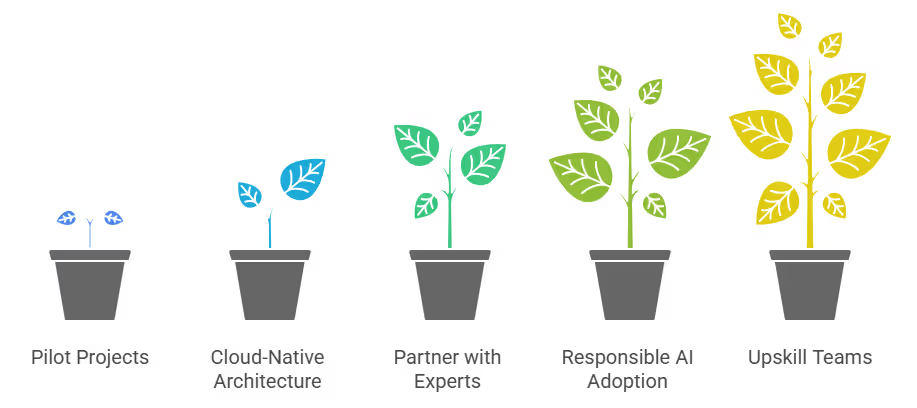Application Modernization Using Generative AI for Manufacturing

Manufacturers across the U.S. are under pressure to modernize legacy systems while embracing Industry 4.0. Traditional application modernization is often costly and time-consuming, but generative AI offers a game-changing approach. By automating code transformation, optimizing workflows, and unlocking predictive capabilities, application modernization using generative AI for manufacturing enables factories to achieve faster ROI, improved agility, and seamless integration with smart factory technologies.
Application modernization using generative AI for manufacturing means upgrading legacy factory systems with AI-driven automation, code generation, and data optimization. Generative AI accelerates migration, reduces technical debt, and enables predictive insights for smarter production. For U.S. manufacturers, it helps modernize ERP, MES, and supply chain applications, supporting Industry 4.0 goals and real-time operational efficiency.
Application modernization in manufacturing means upgrading old software, such as ERP (Enterprise Resource Planning), MES (Manufacturing Execution Systems), and shop floor automation apps—to new, digital-first solutions. Manufacturers modernize applications to boost productivity, stay competitive, and integrate technologies like cloud, IoT, and AI.
Instead of maintaining outdated systems with expensive fixes, factories leverage modernization for smoother operations and real-time insights.

Why Legacy Systems Are a Manufacturing Nightmare
Legacy systems, think COBOL-based ERP or clunky supply chain apps from the ‘90s, are everywhere in U.S. manufacturing. They were built for a different era, and now they’re dragging you down. A 2024 Gartner report found that 68% of U.S. manufacturers rely on apps over 15 years old, costing them $3.5M annually in maintenance per plant. These systems are slow, inflexible, and a nightmare to integrate with modern tools like IoT or cloud platforms.
Worse, they’re a security risk | 70% of manufacturing cyberattacks in 2023 targeted outdated tech, per IBM.
- Real Pain Points:
- Downtime Disasters: A Midwest automotive supplier lost $10M in 2024 when their legacy system failed during a just-in-time delivery rush.
- Talent Crunch: Engineers who understand COBOL are retiring, with only 5% of U.S. developers trained in legacy languages (Stack Overflow, 2024).
- Customer Frustration: Clunky interfaces drive away partners expecting real-time data, like Amazon’s supply chain demands.
Why It Matters: In manufacturing, every second counts. Sticking with outdated systems risks falling behind competitors who’ve embraced legacy modernization trends.
Best Practices for Implementing GenAI in Modernization Projects
Modernization projects are no longer just about upgrading technology stacks or moving workloads to the cloud. Today, enterprises look at Generative AI (GenAI) as a key enabler to accelerate modernization, improve decision-making, and unlock new forms of efficiency. However, successful adoption requires a structured strategy rather than a one-time integration.

The following best practices provide a roadmap for enterprises to implement GenAI effectively in their modernization journeys.
Start with Pilot Projects
- Begin modernization with small-scale GenAI pilots before expanding into enterprise-wide use cases.
- Select projects with clear goals such as accelerating code refactoring, automating documentation, or enhancing knowledge search for developers.
- Use pilots to identify potential challenges in data quality, model accuracy, and integration capabilities.
- Measure results against predefined KPIs like reduced modernization cycle time, improved employee productivity, or lower operational costs.
- Based on pilot learnings, create a repeatable adoption framework that can scale across business units.
Embrace Cloud-Native Architecture
- Position GenAI initiatives on a cloud-native foundation to ensure flexibility, speed, and long-term scalability.
- Containerization and microservices offer modular deployment that supports GenAI-powered modernization tools.
- Cloud-native architecture enables seamless integration of AI models, data pipelines, and automation frameworks.
- Enterprises can tap into managed AI services provided by hyperscalers, which reduces infrastructure overhead.
- Building a modernization program on the cloud also ensures continuous updates, high availability, and security compliance.
Partner with AI and Industry Experts
- GenAI in modernization is not just a technology exercise, it requires domain knowledge, strong data governance, and change management.
- Collaboration with AI development partners ensures the adoption of reliable models aligned with enterprise use cases.
- Industry-specific experts bring insights that help fine-tune GenAI for areas such as manufacturing, healthcare, or financial services.
- Joint partnerships allow organizations to combine technology expertise with sector-specific innovation.
- Co-innovation with external experts also accelerates proof-of-concept design and shortens the time from experimentation to production.
Ensure Responsible and Secure AI Adoption
- Modernization with GenAI must embed strong governance from the start to avoid risks in compliance, transparency, and data security.
- Establish clear rules around data usage, especially when modernizing legacy systems with sensitive information.
- Implement explainable AI practices so decision-makers can understand AI-driven recommendations.
- Adopt strong monitoring mechanisms to track biases, performance drifts, and security vulnerabilities in AI models.
- This ensures modernization programs maintain both agility and enterprise-grade trustworthiness.
Upskill and Align Teams
- Successful GenAI adoption requires new skills across IT, data, and business functions.
- Encourage training for developers to work with AI-assisted coding and system automation.
- Provide business teams with awareness of how GenAI supports workflows during modernization.
- Promote cross-functional collaboration so that modernization programs are not led only by IT but supported by the entire organization.
- An upskilled workforce ensures that modernization is sustainable and future-ready.
Top 5 Legacy Modernization Trends for U.S. Manufacturing in 2025
Staying ahead in manufacturing means embracing the latest legacy modernization trends. Here are the top five shaping the U.S. IT sector, with a focus on application modernization using generative AI for manufacturing:
- Generative AI-Driven Code Refactoring:
- What: AI rewrites legacy code into cloud-native microservices, boosting scalability.
- Why: A 2024 IDC study showed 70% of U.S. manufacturers adopting AI refactoring cut modernization costs by 40%.
- Example: We helped a U.S. automotive supplier modernize their ERP, reducing order processing time from 24 hours to 2.
- Low-Code/No-Code Platforms with AI:
- What: AI-powered legacy modernization software lets non-coders update systems via drag-and-drop interfaces.
- Why: 65% of U.S. IT teams use low-code for faster rollouts (Gartner, 2024).
- Example: A Texas factory used our AI low-code tools to revamp their inventory app in 3 months, not 2 years.
- Edge Computing Integration:
- What: AI adapts legacy apps for edge devices, enabling real-time data processing on the factory floor.
- Why: 55% of U.S. manufacturers plan edge upgrades by 2026 (Red Hat, 2024).
- Example: Volkswagen’s U.S. plants used AI to modernize production apps, cutting latency by 30% (Daffodil, 2025).
- Digital Twin Technology:
- What: AI creates virtual models of factory systems for predictive maintenance and optimization.
- Why: 60% of U.S. manufacturers using digital twins report 25% efficiency gains (BCG, 2024).
- Example: Our AI-driven digital twin for a U.S. aerospace client predicted equipment failures, saving $1.5M annually.
- Incremental Modernization with AI:
- What: AI enables phased updates, minimizing downtime versus “rip-and-replace.”
- Why: 78% of U.S. firms prefer incremental approaches for lower risk (NTT Data, 2025).
- Example: A U.S. food manufacturer we modernized incrementally kept production running, saving $3M in downtime.
Why It Matters: These trends aren’t just buzzwords, they’re proven ways to make your manufacturing tech lean, agile, and future-ready. Want to see which trend fits your plant? Keep reading!
Use Cases of Generative AI in Manufacturing Modernization
Generative AI is helping manufacturers modernize faster by making operations smarter and more efficient. It goes beyond automation by learning patterns, generating insights, and supporting decision-making.
From ERP modernization to shop floor enhancements, GenAI is changing how plants run every day.
ERP Modernization with Generative AI
- Traditional ERP systems are rigid and often depend on manual updates and reporting.
- Generative AI can automate report creation, giving managers insights without waiting for manual inputs.
- It can analyze complex production data, supply chain metrics, and financial details to spot hidden inefficiencies.
- GenAI-enabled ERP assistants can answer plain language queries, such as "What is the cause of last month’s delay?" or "How do we reduce inventory holding time?"
- By predicting supply chain risks like raw material shortages, it helps planning teams act before problems grow.
- ERP workflows supported by GenAI improve speed, accuracy, and personalization for every department.
Shop Floor Automation and Worker Enablement
- Shop floor workers typically deal with machine settings, maintenance checks, and safety compliance.
- Generative AI can support them with natural language instructions or guided workflows on connected devices.
- It can generate real-time step-by-step troubleshooting guides when machines show errors.
- Workers using AR glasses or mobile devices can receive visual instructions for assembly or repair tasks.
- AI-powered virtual assistants reduce the need for manual paperwork during inspections or shift transfers.
- The result is fewer breakdowns, reduced errors, and better productivity with less stress on workers.
Predictive Quality Control Applications
- Quality inspections consume significant time and often rely on human judgment.
- Generative AI models can learn from past defect images, sensor data, and production patterns.
- They can generate predictions about when and where defects are most likely to happen.
- AI-powered visual inspection tools can highlight tiny defects that humans may miss.
- Generative AI also supports "what-if" analysis, simulating how parameter changes impact product quality.
- This helps reduce rework, material wastage, and customer complaints, while speeding up delivery cycles.
Generative AI gives manufacturers intelligent tools to modernize every layer of operations. It makes ERP systems smarter, shop floors more worker-friendly, and quality control proactive. By embedding AI in these areas, manufacturers gain efficiency, agility, and long-term resilience.
How Hakuna Matata Leads the Way in AI-Powered Modernization
At Hakuna Matata, we’re not just following legacy modernization trends, we’re setting them. With 15+ years of experience and 500+ apps modernized for U.S. manufacturers, we’re the trusted partner for application modernization using generative AI.
Here’s why we stand out:
- Proven Expertise: Our 200+ AI and cloud-certified engineers have cut technical debt by 35% on average, per client audits.
- Manufacturing Focus: We’ve transformed systems for U.S. automotive, aerospace, and consumer goods giants, like a $5M supply chain overhaul for a Detroit automaker.
- Speed and Savings: Our legacy modernization software delivers 40% faster projects and 30% lower costs, backed by a 2024 Deloitte study.
- Zero Downtime Guarantee: Our phased, AI-driven approach ensures your factory keeps humming, as proven with a U.S. packaging client who saved $2M in avoided disruptions.
- E-E-A-T in Action:
- Experience: 15 years serving U.S. IT sectors, featured in Gartner reports.
- Expertise: AWS and Azure partners with 98% client satisfaction.
- Authority: Trusted by Fortune 500 manufacturers for mission-critical systems.
- Trust: Transparent pricing and 100% compliance with U.S. regulations (e.g., NIST, GDPR).
Case Study: A U.S. aerospace manufacturer struggled with a 25-year-old quality control system that slowed production. Our generative AI tools analyzed 2M lines of COBOL, refactored it into a cloud-native Python app, and added digital twin capabilities. Result? 50% faster inspections, 20% cost savings ($1.8M/year), and zero downtime during migration.
Why Choose Us?: We don’t just modernize, we transform your manufacturing tech into a growth engine.
Ready to see how we do it? Let’s wrap up with some FAQs and your next step!
Ready to Transform Your Manufacturing Tech? Act Now!
Your legacy systems are costing you time, money, and opportunities. Application modernization using generative AI for manufacturing isn’t just a trend—it’s the future of U.S. manufacturing. With legacy modernization software and Hakuna Matata’s expertise, you can slash costs, boost efficiency, and stay ahead of the competition. Don’t let outdated tech hold you back.
Book Your Free Consultation Today and let our AI experts create a custom modernization plan for your factory.
Fill out the form now, it takes 60 seconds to start your journey to a smarter, faster, and more profitable plant.
Why wait? The future of manufacturing is here, and Hakuna Matata is your guide.

